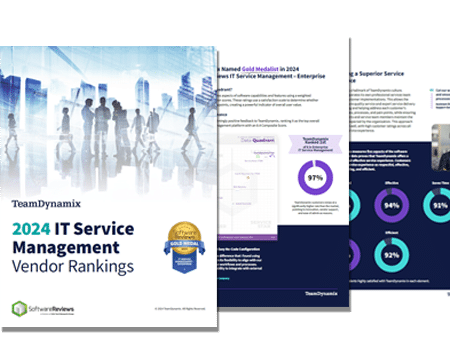
Enterprise Service Management: Why a Unified Platform Matters
Enterprise Service Management (ESM) is the practice of extending IT Service Management (ITSM) principles beyond the IT department to other areas of an organization. ESM

The Info-Tech ranking report offers a unique view of the market based entirely on in-depth customer interviews. Download the Info-Tech ITSM Quadrant and Customer Viewpoint report today.

We’ll show you some of our best situations and show you exactly how to execute them to get immediate results. The best part is, iPaaS tools often feature easy-to-use click and drag functionality, meaning you don’t need a dedicated employee building integrations and workflows.

System Integrators, Value Added Resellers, Technology Providers, and Buying Consortiums can benefit from a partnership with TeamDynamix.

The Info-Tech ranking report offers a unique view of the market based entirely on in-depth customer interviews. Download the Info-Tech ITSM Quadrant and Customer Viewpoint report to gain a better understanding of key vendor strengths and emerging market requirements.
A growing trend in service management and delivery is the integration of chatbot functionality into an organization’s existing IT Service Management (ITSM) platform. By implanting a chat tool with your ITSM software, you can supercharge your self-service capabilities.
It’s important to note, that traditional chatbots don’t fare as well as those built on conversational AI. In fact, a recent market study from CIO.com found that nearly 76 percent of chatbot customers report user frustration with existing solutions. However, When conversational AI is used, the study shows more than 61 percent of respondents could effectively resolve problems vs just 35 percent when traditional chat is used.
It’s a fact that a growing number of companies are investing in self-service as a strategy to help overburdened IT service desks. When you combine automation, self-service and conversational AI – you can have a positive impact on IT resource drain and improve the experience of your customers and end-users.
Conversational AI chatbots are intelligent software applications that can simulate human conversations and perform tasks such as answering questions, providing information and performing transactions.
Conversational AI leverages natural language processing and understands intent. While they do need to be trained, with conversational AI you can facilitate more complex conversations and resolve issues through actions vs. the traditional chatbot’s question/answer limited dialog path.
Because conversational AI chatbots understand intent, they are much more effective when it comes to assisting customers and end-users. For example, when using traditional chat if you say “My password broke” it would likely respond with something like “I’m sorry, I don’t understand that. Please type your issue again,” and continue down that path with a final response that might give you links to 3-5 FAQ articles that it thinks might help resolve the issue – leaving it to the customer to further seek out a solution to the password problem.
When you have conversational AI, if you were to say “My password is broken” it can inform your intent and knows that what you mean is your password isn’t working and needs to be reset. The response from the chatbot is then something like, “I can see you’re having issues with your password. I’ve sent a reset password link to the email on file.”
On the backend, the chatbot can pull the email address needed from the system where it’s stored and automatically send a password reset email – resolving the issue within the conversation in seconds versus sending the customer links and having them do the work to request the link.
By integrating conversational AI chatbots into your ITSM processes, you can achieve several benefits, including:
By adopting conversational AI chatbots as part of your ITSM strategy, you can significantly improve self-service adoption, customer satisfaction and problem-resolution time – all while cutting costs and reducing the drain on overburdened IT resources.
As you start to identify the right conversational AI tool for your organization, you’ll want to plan for the implementation of the new tool, as implementing conversational AI chatbots in your ITSM processes requires careful planning and execution.
Here are some best practices to follow:
If you’d like to learn more about chatbots vs. conversational AI, check out: Chatbot Frustration and the Promise of Conversational AI

Enterprise Service Management (ESM) is the practice of extending IT Service Management (ITSM) principles beyond the IT department to other areas of an organization. ESM

As businesses grow, so does the complexity of managing their services. This is where Enterprise Service Management (ESM) comes in, offering a structured approach to

As IT departments modernize their service management tech stacks, automation stands out as a pivotal force driving significant transformations in how the IT service desk
TeamDynamix’s award-winning SaaS cloud solution offers IT Service and Project Management together on one platform with enterprise integration and automation.
[email protected]
(877) 752-6196
Contact Us
